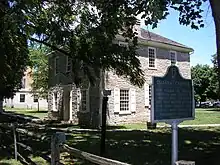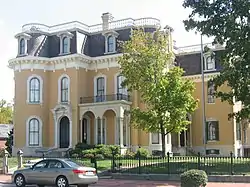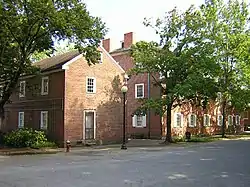 | |
 Indiana State Museum in 2020 | |
 Location within Indianapolis  Indiana State Museum (Indiana)  Indiana State Museum (the United States) | |
| Established | 1869 |
|---|---|
| Location | White River State Park, Indianapolis, Indiana, U.S. |
| Coordinates | 39°46′7″N 86°10′9″W / 39.76861°N 86.16917°W |
| Type | History museum |
| Director | Cathy Ferree (CEO) |
| Curator | Susannah Koerber |
| Architect | RATIO Design[1] |
| Owner | State of Indiana |
| Public transit access | |
| Website | www |
The Indiana State Museum is a museum located in downtown Indianapolis, Indiana, United States. The museum houses exhibits on the science, art, culture, and history of Indiana from prehistoric times to the present day.
History
The original collection of the Indiana State Museum was started in 1862, during the Civil War, when State Librarian R. Deloss Brown began collecting minerals and other curiosities that he kept in a cabinet. In 1869, the Indiana General Assembly enacted a law that provided “for the collection and preservation of a Geological and Mineralogical Cabinet of the Natural History of this State”. A state geologist was assigned the task of labeling and organizing the collection, becoming the first employee of what would eventually become the Indiana State Museum.
The natural history collection quickly developed beyond the legislature's original intent when hundreds of cultural items, many relating to the recent Civil War, were added. Soon the collection was a museum of sorts, with a hodge-podge of curios and specimens.
Indiana Statehouse
The museum's collection was displayed in a spacious room on the third floor of the State Capitol building in 1888, but it did not remain there for long. It was frequently moved from room to room until 1919, when the collection was sent to a most inhospitable place, the basement of the Statehouse. It would languish in this location for almost 45 years, completely closing once in the late 1920s and again in the early 1960s.
During the administration of Governor Ralph F. Gates (1945–1949), steps were taken to establish a new and modern state museum. Staff members who knew how to care for artifacts and operate a museum were hired. Possible sites for a new facility were studied and designs were created. "Philanthropist Eli Lilly, excited by the prospect of a professional-quality museum of Indiana heritage, donated the ground on the northwest corner of Ohio and Senate streets to the state. Unfortunately, the plans fell through, probably due to the $3.5 million price tag."[2]
Later, the administration of Governor Harold W. Handley (1957–1961) and the legislature authorized a commission to examine the state museum. The commission recommended the construction of a building on the site originally proposed by the Gates administration. The commission reported that its members had "been forced to the reluctant conclusion that Indiana has the poorest and most inadequate state museum in the United States".
Old City Hall Building

In 1962, Governor Matthew E. Welsh (1961–1965) approved the resumption of the planning for a new state museum, but with a very different direction. The Indianapolis City Hall at 202 N. Alabama Street had become available in 1961 due to city government offices moving to the new City-County Building. The state and the city worked out an agreement for the museum to use the old building. The structure underwent extensive renovations to prepare it for life as a museum, at a cost of about $830,000. In 1967, the Indiana State Museum opened its doors in its first real home. It had four floors and a basement in which to develop exhibits, store and preserve collections, and provide office space for staff.
In 1969, the Indiana State Museum Society (now the Indiana State Museum Foundation) was established to provide a private, fund-raising support organization. Also in 1969, the Indiana State Museum Volunteer Organization was established to assist the small museum staff. By 1976, the museum had received accreditation from the American Association of Museums, now known as the American Alliance of Museums.
As years passed and the collection grew, the old City Hall became too small to meet the needs of the institution. Proposals were made in the late 1970s and mid-1980s for a variety of additions to the facility. Some involved purchasing nearby buildings and others involved creating brand-new facilities that would connect to the old City Hall building.
Move to White River State Park
The museum's board voted to move to White River State Park in 1984. However, it was not until the late 1990s that the Indiana General Assembly appropriated funds that led to the August 1999 groundbreaking of the current Indiana State Museum.
The Indiana State Museum closed its doors in the old City Hall on December 31, 2001, in order to move to its new home at 650 W. Washington Street, opening there on May 22, 2002. The new building on the Indiana Central Canal in White River State Park cost about $105 million.[3]
Galleries
With more than 40,000 square feet (4,000 m2) of exhibit space, the museum's galleries cover the history of the natural world, Native Americans, cultural history, and the future of Indiana.
Gov. Frank O'Bannon Great Hall

- Dean and Barbara White Auditorium
- Legacy Theater: The Indiana African American Experience
First floor

- Gallery One
- Ancient Seas
- R.B. Annis Naturalist's Lab
- Frozen Reign
- First Nations
- Natural Regions
Second floor

- Contested Territory
- 19th State
- The Hoosier Way
- Crossroads of America
- Enterprise Indiana
- Global Indiana
- American Originals
- Firefly Landing
Third floor
- Rapp Reception Hall
- The Ford Gallery
- NiSource Gallery
- South Gallery
- Thomas A. King Bridge
- Lincoln Financial Foundation Gallery
92 County Walk
The 92 County Walk is an art experience incorporated into the building's façade that spotlights Indiana's 92 counties by featuring an original sculpture for each county. The sculptures are made of limestone, aluminum, glass, and other materials, and represent the uniqueness of each Indiana county.[4]
Collections
The museum's collection consists of items relating to Indiana's history, arts, and natural sciences. The collection of more than 500,000 objects contains six focus areas, which the museum refers to as "Centers of Excellence." These areas are Ice Age paleontology, Abraham Lincoln, Indiana art and artists, quilts and textiles, Indiana industry, technology, and agriculture, and Indiana archaeology.[5]
State Historic Sites
The museum is part of the Indiana State Museum and Historic Sites. This statewide institution maintains the museum and 11 state historic sites. Each site interprets the history of an important person, place, or event in Indiana's history.
Indiana State Historic Sites
| Site name | Image | Nearest city | County | Description |
|---|---|---|---|---|
| Angel Mounds State Historic Site |  | Evansville | Vanderburgh and Warrick | Archaeological site with surviving major earthwork mounds that was constructed and inhabited by the Mississippian culture between 1000 and 1450CE. The site was later excavated by noted archaeologist Glenn A. Black.[6][7] |
| Corydon Capitol State Historic Site |  | Corydon | Harrison | Historic district that includes Indiana's original state capitol, the first state office building, and Governor William Hendricks' Headquarters. |
| Culbertson Mansion State Historic Site |  | New Albany | Floyd | Second Empire-style mansion built by industrialist William S. Culbertson in 1867 at a cost of $120,000. It contains 25-rooms within 20,000 square feet (1,900 m2) and was completed in November 1869.[8] |
| Gene Stratton-Porter State Historic Site |  | Rome City | Noble | Second home of naturalist and author Gene Stratton-Porter located along Sylvan Lake where she lived from 1914 to 1919 prior to relocating to California. |
| Lanier Mansion State Historic Site |  | Madison | Jefferson | Historic house museum situated along the Ohio River built by J.F.D. Lanier, a prominent banker, railroad financier, and co-founder of Winslow, Lanier & Co. The mansion was designed by noted architect Francis Costigan and completed in 1844.[9] |
| Levi & Catharine Coffin State Historic Site |  | Fountain City | Wayne | Home built by abolitionists Catharine and Levi Coffin in 1838–1839, later known as the "Grand Central Station of the Underground Railroad."[10] |
| Limberlost State Historic Site |  | Geneva | Adams | Log cabin home built by Gene Stratton-Porter and her husband Charles Porter in 1895 that derives its name from its location near the Limberlost Swamp, which served as inspiration for many of Stratton-Porter's novels.[11] |
| New Harmony State Historic Site |  | New Harmony | Posey | District in the historic town of New Harmony founded by the Harmony Society, including buildings such as the Mattias Scholle House. Later inhabited by Robert Owen and his Owenites. |
| T. C. Steele State Historic Site |  | Nashville | Brown | Picturesque property containing the home and studio of Hoosier Group artist Theodore Clement Steele and his second wife, Selma Neubacher Steele, as well as formal gardens and other natural features. |
| Vincennes State Historic Sites |  | Vincennes | Knox | Vincennes is Indiana's oldest city and original territorial capital. This district contains many early important buildings including the Indiana Territorial Capitol, Old State Bank, and Brouillet House.[12] |
| Whitewater Canal State Historic Site |  | Metamora | Franklin | Part of the Whitewater Canal that spanned 76 miles from Lawrenceburg, Indiana to Hagerstown, Indiana, this site contains the Duck Creek Aqueduct in Metamora, which is the only remaining wooden aqueduct in the United States.[13] |
See also
References
- ↑ "Indiana State Museum".
- ↑ "About".
- ↑ Price, Nelson (2004). Indianapolis Then & Now. San Diego, California: Thunder Bay Press. p. 81. ISBN 1-59223-208-6.
- ↑ "Indiana State Museum: Art & Architecture". RATIO Architects.
- ↑ "Collection".
- ↑ "Angel Mounds State Historic Site". Glenn A. Black Laboratory of Archaeology.
- ↑ James H. Kellar (1967). "Glenn A. Black". Indiana Magazine of History. Retrieved 2020-11-23.
- ↑ Richard K. Stem (1974-06-03). "National Register of Historic Places Inventory-Nomination: Culbertson Mansion". U.S. Department of the Interior, National Park Service. Retrieved 2020-11-23.
- ↑ "Lanier Mansion". U.S. Department of the Interior, National Park Service.
- ↑ Joseph S. Mendinghall; S. Sydney Bradford (1975-09-26). "National Register of Historic Places Inventory-Nomination: Levi Coffin Home". U.S. Department of the Interior, National Park Service. Retrieved 2020-11-23.
- ↑ "Limberlost Cabin". Indiana Division of Historic Preservation and Archaeology.
- ↑ "Old French House". Indiana Historical Bureau. 16 December 2020.
- ↑ "Duck Creek Aqueduct". Indiana Architectural Foundation. 2018-10-24.
External links
Indiana State Museum.